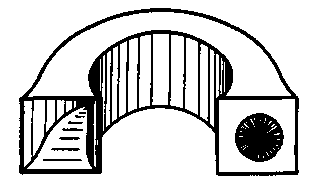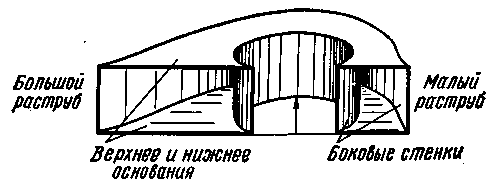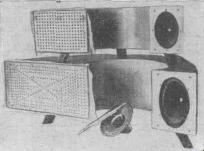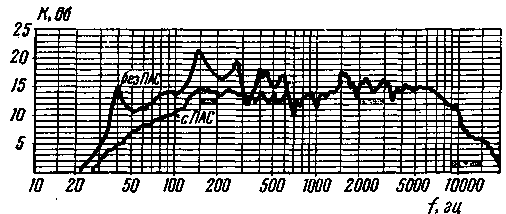One reason for the poor performance loudspeaker in the field low audio frequencies is the interaction of the radiation side of the diffuser.
To combat that phenomenon it is necessary that the design of the loudspeaker, which, for optimal acoustic load is shared by these radiations. From this point of view, of interest is the phase inverter in which the radiation from the back side of the diffuser is used to increase efficiency at low audio frequencies. However, the conventional phase inverter that operates at frequencies of the order of 40 Hz, must have a significant amount and therefore not widely used.
The search for a better solution to this problem has led Moscow ham A. Presnyakov to the creation of the acoustic unit, which he called the "horseshoe" (Fig. 1).

Fig.1
The unit was shown at the XVII all-Union exhibition of the art of Amateur radio. Like shout it serves as a waveguide for propagating it sound vibrations and has increased efficiency at low audio frequencies. Along with great dignity, this unit has a major drawback. It set a loudspeaker is loaded on tapering towards the middle of the pipe, so that the diffuser is formed as prekopova chamber of a large volume. As a result, the frequency response curve of the loudspeaker appears a number of bursts and dips, worsening its uniformity. Obviously, it is more appropriate to produce the acoustic unit is not in the form of a horseshoe, tapering towards the middle, and in the form of a horn, rolled in a horseshoe (Fig. 2).

Fig.2
Forming horn, as in unit A. Presnyakov, have only the side walls, top and bottom cover its parallel. The loudspeaker is mounted in a narrow part of the horn, in this case is loaded on expanding the pipe. As a result, not only eliminates unwanted resonances, but also improves the coordination of the high radiation resistance of the loudspeaker low impedance environment.
The author has made several such units of different size. Two of them are shown in Fig. 3; top there is a "small horn-reflex", a volume of 50 dm3 working with loudspeaker GD-1, and below the "big horn bass reflex", volume 140 dm3 working with loudspeaker GD-1.

Fig.3
Both units can be used with other speakers. As shown by measurements made in the laboratory of electroacoustics, NIKFI, units have a satisfactory frequency characteristic of sensitivity. One of the characteristics of small bass reflex speaker GD-1 panel with acoustic resistance (PAS) and without it is shown in Fig.4.

Fig.4
Frequency response sensitivity big horn bass reflex speaker GD-1 was cited in the journal "Radio" N 4, 1969, p. 28, Fig.4.
The sound of the horn of inverters has a nice peculiar timbre, due to the high efficiency of radiation at low audio frequencies. Especially well-played jazz music performed by small ensembles. For high-quality playback of symphonic music units can dampen the panels PASS (Fig. 3). PAS is mounted in the cap covering the great bell of the unit. Holes with a diameter of 10-30 mm or blinds width of 10 mm and a length in the whole cover should be evenly distributed over its entire area. PASS, like any other movable damping of the loudspeaker system, reduces its efficiency, so their use depends on the taste of ham and cannot be recommended as mandatory. For comparison, the table shows the magnitude of the efficiency of the loudspeaker 4A-28 measured by recording the polar radiation patterns for different types of registration. As the table shows, panel a PASS reduces the efficiency at low frequencies, however, when working with horn bass reflex he remains quite high. Almost horn-reflex system allows using a single loudspeaker to sound hall with a capacity of 50-70 people, for example, cafe, restaurant, club or hall of the school.
In a small room (foyer, hall), horn phase inverter can be operated from a standard single-ended amplifier WOOFER with lamp PP PA output.
Native speakers used device (tape recorder, radiograms) must of course be disabled. In the living room you can receive a significant volume when connected to the horn bass reflex even a transistor radio type "Spidola" without an additional amplifier.
Despite the rather complex configuration, manufacturing of the unit does not require special skills and available to every ham radio operator. This requires two standard thick sheet (12 - 15 mm} and two or three sheets of conventional thin-layer plywood. To cover the large socket will need an additional piece of thick plywood, the small cover on the socket can be made from crop remaining after cutting out the top or bottom of the flared base. Still need casein glue and 5-6 rolls of elastic bandage (rubber band, sold in pharmacies).
Work begins with marking the upper and lower bases. The layout of the grounds is the most important operation. Previously in this you can work out on a sheet of paper. Then, laying down a thick sheet of plywood, from right near the corner applied dimensions - diameter and depth (height) of the speaker that you want to use in the unit. Left margin 15 mm on each side, proceed to the markup (Fig. 2).
After a small contraction, following directly behind the speaker, it must be a smooth extension of the base, ending in a characteristic bell in the left middle corner of the sheet of plywood. It is desirable that the shape of flares was symmetrical. Having marked one base, the resulting shape is transferred to another sheet of plywood. After that, both the base cut out and knock together by nails. The nails are preferably placed as shown in Fig. 5, then the holes can be reused.

Fig. 5. In parentheses are the size of a large bass reflex.
When trying grounds, nails should not drive until the end, so they can be pulled out easily. Finishing the highlanders to produce better tracewin a file, but so that there is no chipping of the upper layers of plywood. After treatment the Foundation of the divide.
h, at frequencies % \ View acoustic design
100 Hz
160 Hz
315 Hz
5000 Hz
h, % AVG.
Big horn bass reflex without a PASS
3,36
3,03
2,16
0,6
2,29
Big horn bass reflex design with a PASS
1,08
2,14
1,86
0,53
1,40
Sealed box volume 120 dm3
0,66
0,73
0,94
0,68
0,75
The side walls are made of three layers of thin plywood, glued successively at each other. For this purpose, a thin sheet of plywood should be cut into strips across the grain of the outer layers. The length of the strip of plywood should be at 40 - 60 mm more than the length of the generatrix of the cover (allowance for processing). The bandwidth determines the height of the unit. It is found, based on the diameter of the loudspeaker, twice the thickness of the base, the margin of 20-30 mm and, finally, the allowance for processing. After producing six strips of plywood, wood should be cut into eight racks. The length of the uprights must be equal to the height of the unit from the inside, the cross section of their 60X60 mm Rack installed on a flat surface and put them on one of the grounds (see Fig. 5). After this grounds but the existing holes nailed to the uprights.
So when you glue the side walls of plywood was arched, location racks from the edges of the socket must match with the side forming unit. Similarly nailed to the uprights second base, pre-aligning it towards nailed using a carpenter's corner. Before applying glue, plywood useful to moisten with water. The first layer of the side walls easier to glue together. A strip of plywood glued to prepared in the same manner the ends of the bases, starting from the middle, tightly winding unit elastic bandage round. Due to the tension of the rubber thin plywood tight to the grounds around the perimeter. Drying time of the glue 6-8 hours. In the same way paste the second and subsequent layers of the plywood side walls, but now glue should lubricate the entire surface of the cover strips.
Gluing the casing, pull nails, fastening the rack is removed, and the holes from the nails densely hammer wooden sticks, the protruding ends of which are cut flush with a knife. After that, proceed to the final finishes of the unit. A jig saw round projecting edges of the side walls and handle their tracewin file. The socket disclose customer is treated so that they could fit snugly cut from thick plywood cover.
Fit the lid, you need to set them in place. To do this, at the corners of the sockets should be strengthened from the inside with screws or screws steel corners and threaded for screws M4. Screws, skipped through the lid of the socket, firmly hold them in place. The unit is mounted with covers of flares should be treated with sandpaper to obtain a smooth surface. In conclusion, the outer surface of the unit can be used to paste veneer of precious wood and Polish. However, this work requires some skills. In the absence of veneer can advance to find the wood pattern on the outer layers of plywood, cover the unit with a varnish and Polish.
The cap fits snugly against the edges of the sockets, their perimeter must be glued strips of felt or thin cloth. If the unit is supposed to be used without a PASS, from the cover on the great trumpet shall be cut frame. In the small cap cut out the hole for the speaker. Both covers can be fitted not very thick cloth, and through it is not visible holes, the outer surface of socket covers useful to dye ink, diluted with water.
Author: Ing. V. Environment And Experiments; Publication: N. Bolshakov, rf.atnn.ru






